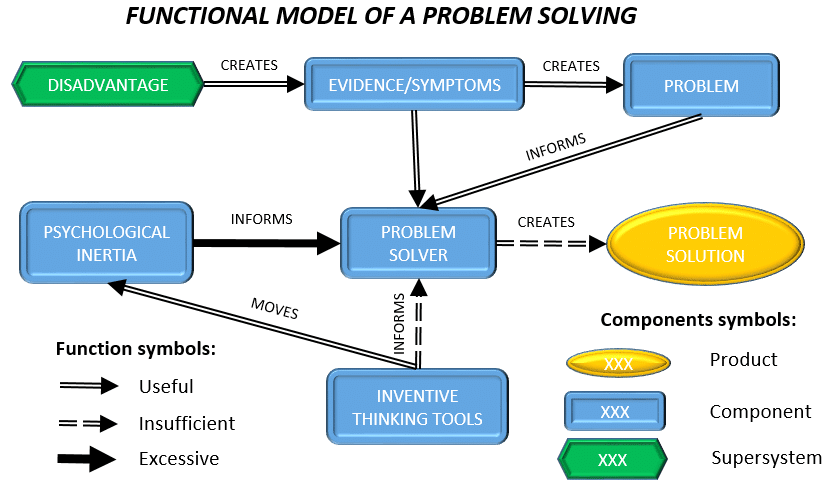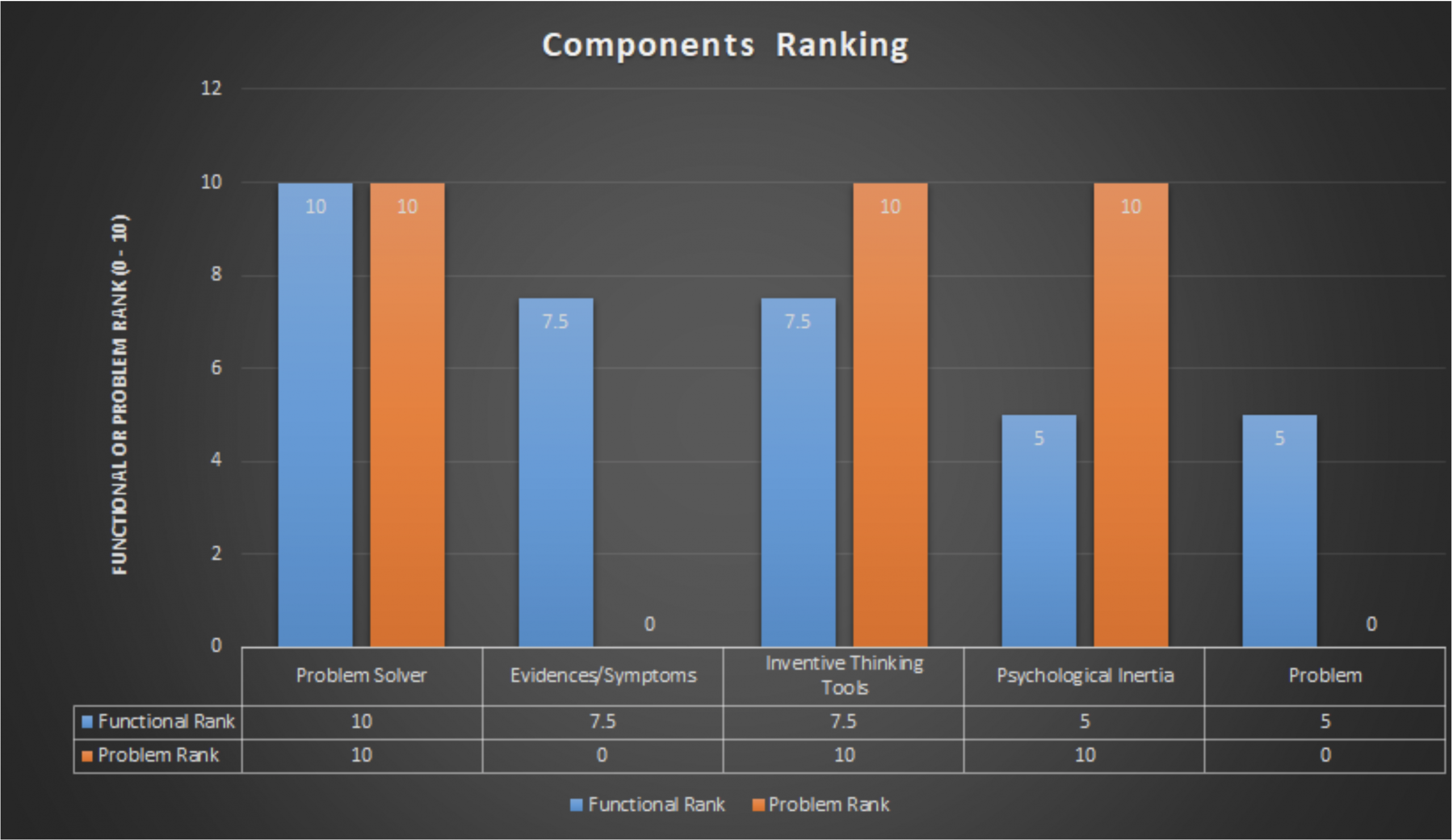A problem solver often embodies the hope and potential for overcoming challenges. However, paradoxically, the problem solver can also become the primary obstacle in effective problem-solving. This unexpected barrier emerges primarily due to psychological inertia, a cognitive bias that limits creative thinking by binding individuals to past experiences and established solutions.
Let’s analyze the problem-solving process. From our perspective, Functional Modelling (one of the well-known TRIZ tools) is the best way to analyze a system. An additional article describing Functional Modeling (FM) in greater detail will be prepared and published later on. For the purpose of this discussion, we are going to provide a very brief explanation of how the Functional Model tool helped me to investigate the problem-solving process.
At a high level, the principles of the FM tool are as follows:
All relevant components of a system are mapped and connected with arrows according to an existing functional relation between the components. In addition to the system components, a product (an objective of the system functionality) and super-system components (components that are not direct parts of the system) should be defined and taken into consideration.
Functions could be of four types:
For the purpose of this analysis, we built a Functional Model of the problem-solving process (our system) and assigned the components as follows:
The resulting Functional Model is shown on the chart below.

Note: This is our vision of the problem-solving Functional Model. You are more than welcome to disagree, comment, and propose your versions. Please, leave your comments below the end of this post.
Based on the model above, we have calculated the Functional and Problem Ranking of the system components. The component with the highest Functional Rank is the main contributor to the successful creation of the “product”. Problem Rank indicates components that prevent the successful creation of the “product”.
The Functional and Problem Ranking chart is shown below:

Based on the ranking chart we can extract interesting conclusions:
Summarizing the ranking, we can point out that Problem Solver is the most creative component of the system. On the other hand, Problem Solver, Inventive Thinking Tools, and Psychological Inertia are the most problematic components of the system.
Both, Inventive Thinking Tools and Psychological Inertia do not operate without a Problem Solver; therefore, a Problem Solver is the most problematic and the most creative component simultaneously.
Psychological Inertia and Inventive Thinking Tools affect the result in opposite directions:
How does the problem solver restricts the success of problem solving process? What are the roadblocks?
This is a very typical situation when people are trying to avoid inventive thinking tools while they honestly believe that it will take them a very long time to achieve the result. While being under stress to solve a problem, the majority of people prefer to use artless brainstorming rather than problem solving instruments. They invite their colleagues to the meeting and start collecting ideas generated spontaneously. In most cases, the ideas are not even related to the problem. In this situation, people are strongly affected by psychological inertia and propose a number of well-known solutions, but they are motivated by what it is easier to accomplish instead of concentrating on solving the actual problem.
Artless brainstorming is similar to gambling in a casino and cannot bring any reasonable solution to the problem.
Trying to provide a solution fast, people prefer to skip the Failure Description (Disadvantage, Evidence, and Symptoms) and jump directly to the problem statement.
This is a huge mistake!
The Failure description is the only correct method for building the correct Problem Statement. More often than not, a disadvantage is treated as a problem. For instance, in the case of a punctured tire, they define the actual puncture as a problem. And that is incorrect! The punctured tire is a disadvantage resulting in evidence – the release of air from the tire. Disadvantages and evidence cannot be solved, therefore they cannot be problems. The problem is the fact that you now have to act differently from what you originally planned.
For example, you cannot continue driving, you cannot get to a destination on time, you have to cover the unplanned costs of repair.
The problem is not what you see, hear or feel; the problem is what you should do as a result of what you see, hear or feel.
The description of failure evidence and correct problem statement definition is a crucial step that cannot be skipped.
Often people make a mistake and assume that the root cause of the problem is a fundamental reason for the occurrence of the problem. This is an incorrect approach, as a fundamental reason typically cannot be fixed or even changed. The correct root cause should be chosen based on the capability to remove or reduce the defect and solve the problem. A root cause is a source of the problem that if terminated, the problem is removed or solved.
Cause and Effect Chain (CEC) Analysis is an excellent tool for a root cause search. The tool looks trivial, but in reality, it is more complex when the analysis is performed. Starting from the Target disadvantage a problem solver is required to answer a single easy question: “Why?”. And he has to answer honestly and reasonably.
There is another important requirement of CEC, it should be completed all the way down to the endpoint (dead-end). Where the dead-end is the cause that cannot be fixed or changed.
Once the entire chain is completed, we can be sure that all possible causes are on the list. We can then start choosing an acceptable root cause by moving upwards from the dead-end to the target disadvantage.
A brief example of a punctured tire is shown below:

We defined all the causes of the Cause-Effect Chain and got to the dead-end. So, the dead-end is a fundamental root cause but it is useless for solving the actual problem. As one can see, all intermediate causes are much more useful since each one of them could help us to generate ideas and solve the problem.
Note: The CEC tool is still under development and we will release a dedicated article once released.
A root cause is not the fundamental reason for the failure, a root cause is the source of the failure that is chosen as a reasonable step for the failure elimination or reduction.
The creation of a failure model is the
A failure model is a description of the features that
A system model is a description of the system’s operation including interactions between its components.
It is virtually impossible to build a failure model without the system model available.
The system model can be built using functional modeling. It will help you learn how the system operates, it will assist you in the understanding of failure mechanisms and guide you to the failure model creation.
Typical mistakes:
Create a number of models, validate them and use only the valid model for solving the problem.
It is very common that a problem solver brings a brilliant idea or solution to the table, but others are not ready to accept it and even actively resist the implementation. They do not believe that the proposed solution is the correct one, because the solution is, so-called, unexpected.
This is a very well-known phenomenon and resulted from pattern recognition.
Pattern recognition features:
Please remember that finding a
Be inventive to overcome pattern recognition when managing the implementation and destiny of your idea.
Please click any orange button to get to our online innovation platform. Start to innovate.
LOGIN to PRIZ Innovation Platform and start your project.
Navin
April 9, 2019
I liked the article… Very interesting and creative way of applying FM to problem solving process itself.
Anatoly
April 10, 2019
Hi Navin,
Many thanks for your attention and your comment. We are going to collect inventive thinking tools and explain to people how it is important to use the tools. We are going to proliferate TRIZ and problem-solving strategy and tactic.
You are kindly invited to post what you think on problem-solving or on any specific problem-solving tool.
Many thanks again,
Anatoly
Victor Meirovich
April 11, 2019
Great work with a beautiful interface. In a couple of days I will try to use the solver for one idea…
Anatoly
April 11, 2019
Victor,
Thank you for your attention and comment. Try to use an application. Solve a problem with our application. It will definitely guide you to the solution. I would recommend to start with RRR – Round-Robin Ranking that is built for items/tasks ranking (prioritization) and making decision. Enjoy.
Thank you,
Anatoly
Michael Nikiforuk
April 13, 2019
Great article Anatoly – I really liked your use of the Roadblock Models to define or analyze “the reality” of a “predicament” – great perspective on collective thinking – sometimes leading to “noise” as opposed to solution(s) – the difficulty in assessing a new idea – very good / thoughtful work!!!
Anatoly
April 13, 2019
Many thanks, Michael.
The idea is that the person is the main source of the problem and he is the main barrier in the problem-solving process. Many thanks again. Let’s continue to understand what problem-solving is.
michael nikiforuk
April 15, 2019
Anatoly – that is so true – so very, very true!!!
Amos Redlich
April 30, 2019
Finally, I found the time to read carefully your article and I found it very interesting.
Nevertheless, I have a few questions:
How do you evaluate the functions rank in the chart? Is this your subjective assessment?
What are the meaning of the terms “failure description” and “failure model”? how do you formulate them? (It worth a separate article)
In the Puncher example, I think that the problem solver should formulate the desired situation versus the current situation. If the problem will make me late for the wedding then it is best to solve the problem of lateness rather than replacing a wheel (by the way, I also wrote an article with a similar example and I will appreciate your comments https://www.linkedin.com/feed/update/urn:li:activity:6517678330840444928 )
Anatoly
April 30, 2019
Amos, many thanks for your questions. Excellent questions. I am crazy about Funktional Modelling. I think this is the best way to learn how a system is working, to create a failure model and find solutions that never can be found in other ways. Functional Modelling. When you create a functional model – the functional connection between different components you are putting a lot of questions and looking for answers. There is no better way to understand how a system operates. Since the functional model is completed you can assign functional and problem ranks. You can find in the internet different ways to calculate the ranks, I use what I have learned from excellent mentors from GEN3. Everything is related to the value of the component. The calculation is similar to the Ideality by Altshuller. Value = Function/(Problem + Cost). The functional rank is calculated based on the component location, how far the component from the product. The problem rank is calculated from the component’s harmful function occurring. So, this is a long story, that I cannot explain here. Since you created a functional model and defined functional and problem rank your mind is already ready for the creation of a physical model of the failure. At least that has typically happened in my case. I just started to understand (to really see) how the failure appears and start to generate the model of failure. When the model of failure is created there is no problem to find a solution. Unfortunately, in many cases, the solution is not accepted, but it is found.
Thank you, Amos. I really like Functional Modelling.